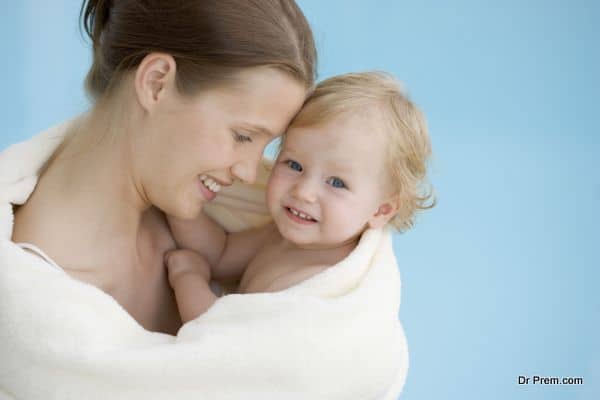Babies grow rapidly from a feeble newborn to an active toddler. This growth rate depends on certain milestones that are classified into three categories: motor development, language development and social development. As a parent, you should record your baby’s progress and find out if your little one is on the right track towards his/her growth or not.
The first month
Common skills
Babies are reflexive in behavior during the first month. Their reactions are automatic and their actions depend on reflexives. By gross motor reflexive behavior, babies can move their head from side to side when on stomach. They extend their arms and legs away at a loud noise. Similarly, fine motor reflexive behavior indicates that a child has a strong grasp that is prominent in his/her first month. Mouthing reflexives are in fact, most important for babies survival. It helps them locate the source of their food. Another reflexive is rooting reflexive which is prevalent in babies until they grow up to four months and it starts fading after this age.
Skills still learning
By the end of the first month, a baby exhibits some actions like raising head, tracking movements with eyes, keeping hands in tight fists.
1-3 months
Common skills
Between the span of three months, a baby starts transforming into an active child and breaks free from being dormant. Many reflexives like startling, rooting or grasp are lost by this age. A baby now smiles responsively and plays with fingers as well. They become socially responsive as they turn towards familiar voices and tend to follow moving objects and people at a distance. Babies during first and third month, can bring their hands to mouth and even shake hand toys.
Cognitive behavior of cooing develops in babies at this stage. They start using their eyes and hands in coordination to recognize things around them. The arms and hands movement develop quite fast , and the once tight grip, starts opening up frequently to grab things. Babies try to explore things by smacking them in their little mouths at once.
Skills still learning
By the time babies complete three months of age, they become more responsive and develop cooing skills to respond to voices. They develop using arms and legs more vehemently.
4-7 months
Common skills
In the tenure of four to seven months, babies learn to use their arms and legs to roll over in one or the other direction. They learn to transfer objects from one hand to other. In this way, they learn to enhance their motor skills by grasping toys, trying to sit up, rolling over and at times, even crawling. Babies seem to have more control in their actions now, as they can express themselves with strong emotions, by crying or smiling. They start blowing ‘raspberries’ now by spitting bubbles while babbling. By now, babies are able to push up using their arms to chest. Their range of focusing on objects also changes as they shift their interests to complex designs and patterns.
They tend to lift up their head that helps in strengthening their upper body, to eventually get prepared for sitting up without support. In this time between four and seven months, babies can comfortably roll over their stomach to back and back to stomach.
Skills still learning
By the end of this span, babies learn to respond to people’s expressions of emotions through babbling. They become interested in exploring objects with hands and mouth by shaking and banging them. They can laugh loud as well.
8-12 months
Common skills
By this age, babies can sit up well without support. They respond when somebody calls their name. They pay attention to interactive games now and display their emotions by clapping hands. They start with crawling and even try scooting at this age as they are in a constant motion. By twelve months of age, most babies take their first step. However, this can be earlier or delayed in some children which is quite normal. Babies begin to use the pincer grip between these ages, and become fascinated for poking their fingers through holes.
At this age, babies face stranger anxiety. They become distressed on seeing a stranger and react in a similar, anxious manner if they see their parents leaving. They learn using simple gestures, as waving for ‘bye’, and shaking hands to ‘greet’ someone. Babies discover permanency in objects near to them and try to use them correctly, such as holding a phone close to the ear.
Skills still learning
Towards the end of this duration, babies feel separation anxiety and stranger anxiety, which remains in them for some time.
On to toddlerhood
Common skills
In the first year of life, babies learn many things and proceed through the milestones of mental, physical, emotional and social growth. They become more independent and responsive in their behavior after the completion of first year. In the phase of toddlerhood, babies take a step further on their own, and develop stronger communication with parents and familiar people. They can express their wants, happiness, disappointment and distress in few gestures and different cries. They grow amazingly, and normally triple their weight at birth. They develop an engaging relationship with people around them and begin with a mutual interaction.
Skills still learning
Babies become more responsible about themselves by the end of first year, and now they get ready to develop their skills like talking, thinking and walking for the next stage of their life which is toddlerhood.



